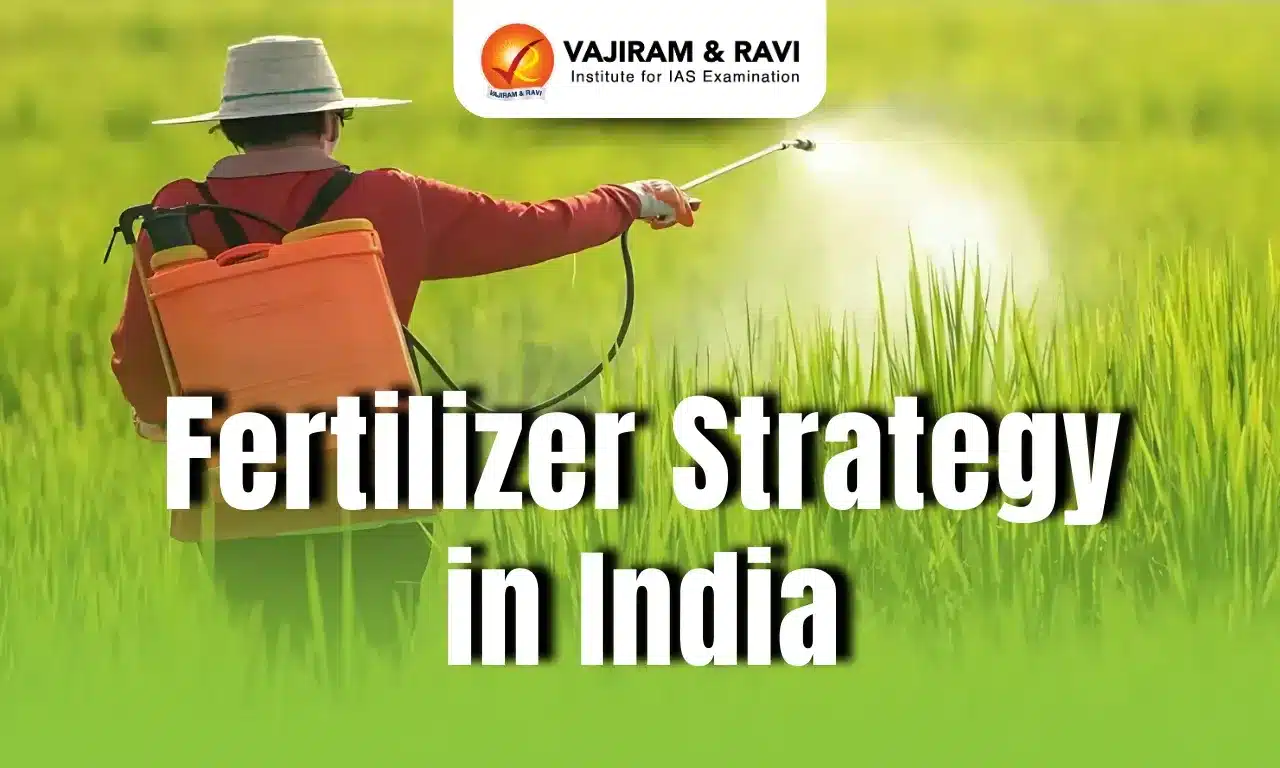What’s in Today’s Article?
- Fertilizer Strategy in India Latest News
- India’s Dependence on Imported Fertilisers
- Need to Limit the Usage of Urea, MOP, and DAP
- An Effective Replacement for DAP: Ammonium Phosphate Sulphate (APS)
- The Road Ahead
- Fertilizer Strategy in India FAQs
Fertilizer Strategy in India Latest News
- India aims to cap or reduce the consumption of urea, di-ammonium phosphate (DAP) and muriate of potash (MOP) due to their heavy reliance on imports.
India’s Dependence on Imported Fertilisers
- MOP: Fully imported from Canada, Russia, Jordan, Israel, Turkmenistan, and Belarus due to the lack of domestic potash reserves.
- Urea: Over 85% of demand met domestically, but production depends on imported liquefied natural gas (LNG) from Qatar, the US, UAE, and Angola.
- DAP: imported in the form of
- finished fertiliser (mainly from Saudi Arabia, China, Morocco, Russia and Jordan) as well as
- raw material (rock phosphate from Jordan, Morocco, Togo, Egypt and Algeria; sulphur from UAE, Qatar and Oman) and
- intermediate chemicals (phosphoric acid from Jordan, Morocco, Senegal and Tunisia; ammonia from Saudi Arabia, Qatar, Oman and Indonesia).
Need to Limit the Usage of Urea, MOP, and DAP
- High Import Dependence and Currency Depreciation
- India heavily relies on imports for MOP and DAP, while urea production depends on imported liquefied natural gas (LNG).
- The rupee’s depreciation further increases the cost of these fertilisers, putting pressure on foreign exchange reserves.
- Imbalance in Nutrient Application
- Urea (46% nitrogen), MOP (60% potash), and DAP (46% phosphorus + 18% nitrogen) are high-analysis fertilisers.
- Most crops do not require such high concentrations of individual nutrients, leading to inefficient nutrient absorption and wastage.
- Need for Balanced Fertilisation
- Crops require a mix of macronutrients (N, P, K), secondary nutrients (sulphur, calcium, magnesium), and micronutrients (zinc, iron, copper, boron, manganese, molybdenum).
- Excessive use of high-analysis fertilisers disrupts soil health and reduces long-term productivity.
- Efficient Use of Resources and Foreign Exchange
- Reducing dependence on high-analysis fertilisers ensures better utilisation of imported raw materials.
- Balanced fertilisation promotes sustainable farming, enhances crop yields, and reduces unnecessary expenditure on imports.
An Effective Replacement for DAP: Ammonium Phosphate Sulphate (APS)
- APS (20:20:0:13) contains 20% nitrogen (N), 20% phosphorus (P), and 13% sulphur (S) but no potassium (K).
- Despite having lower phosphorus content than DAP (which has 46% P), APS is an effective alternative due to its balanced nutrient composition.
- APS manufacturing reduces dependence on costly phosphoric acid, making fertiliser production more economical and resource-efficient.
- The inclusion of sulphur improves soil health and enhances crop yield, making APS a viable and sustainable alternative to DAP.
- APS is ideal for oilseeds, pulses, maize, cotton, onion, and chilli, which require high sulphur content.
- DAP should be reserved for wheat, rice, and sugarcane, where it is most essential.
- Also, companies benefit by selling twice the number of APS bags from the same phosphoric acid quantity, making APS a more financially viable option.
The Road Ahead
- Surge in NPKS Complex Fertiliser Sales
- NPKS fertiliser sales in 2024-25 are projected to reach 14 mt, nearly double the 7.3 mt in 2013-14.
- The rapid growth is largely driven by 20:20:0:13, which is steadily replacing DAP.
- Expanding the Push for Balanced Fertilisation
- Other complex fertilisers like 10:26:26:0, 12:32:16:0, 15:15:15:0, and 14:35:14:0 need stronger marketing efforts.
- Direct application of MOP should be minimised, with its usage integrated into balanced complex fertilisers.
- Reducing Dependence on High-Analysis Fertilisers
- The long-term goal is to limit or reduce the use of urea, DAP, and MOP, ensuring efficient nutrient application.
- Farmers should be encouraged to maximize nutrient use efficiency, leading to better crop productivity while conserving foreign exchange.
Fertilizer Strategy in India FAQs
Q1. What is called fertiliser?
Ans. Fertiliser is a substance added to soil to supply essential nutrients, enhancing plant growth and crop yield.
Q2. What are the top 3 fertilizers?
Ans. The top three fertilizers are urea (nitrogen-rich), DAP (phosphorus and nitrogen), and MOP (potassium-rich), crucial for agriculture.
Q3. What is urea in fertilizer?
Ans. Urea is a nitrogen-rich fertilizer (46% nitrogen) that enhances plant growth but requires proper application to prevent soil degradation.
Q4. What is the urea formula?
Ans. The chemical formula of urea is CO(NH₂)₂, consisting of carbon, oxygen, and nitrogen, widely used in agriculture.
Q5. Which is better, NPK or urea?
Ans. NPK fertilizers provide balanced nutrients (N, P, K) for plant growth, while urea supplies only nitrogen, making NPK better for overall fertility.
Source: IE
Last updated on December, 2025
→ Check out the latest UPSC Syllabus 2026 here.
→ Join Vajiram & Ravi’s Interview Guidance Programme for expert help to crack your final UPSC stage.
→ UPSC Mains Result 2025 is now out.
→ UPSC Notification 2026 is scheduled to be released on January 14, 2026.
→ UPSC Calendar 2026 is released on 15th May, 2025.
→ The UPSC Vacancy 2025 were released 1129, out of which 979 were for UPSC CSE and remaining 150 are for UPSC IFoS.
→ UPSC Prelims 2026 will be conducted on 24th May, 2026 & UPSC Mains 2026 will be conducted on 21st August 2026.
→ The UPSC Selection Process is of 3 stages-Prelims, Mains and Interview.
→ UPSC Result 2024 is released with latest UPSC Marksheet 2024. Check Now!
→ UPSC Prelims Result 2025 is out now for the CSE held on 25 May 2025.
→ UPSC Toppers List 2024 is released now. Shakti Dubey is UPSC AIR 1 2024 Topper.
→ UPSC Prelims Question Paper 2025 and Unofficial Prelims Answer Key 2025 are available now.
→ UPSC Mains Question Paper 2025 is out for Essay, GS 1, 2, 3 & GS 4.
→ UPSC Mains Indian Language Question Paper 2025 is now out.
→ UPSC Mains Optional Question Paper 2025 is now out.
→ Also check Best IAS Coaching in Delhi

















